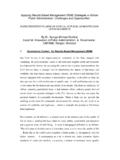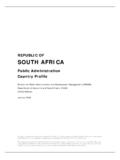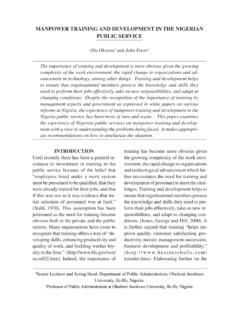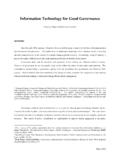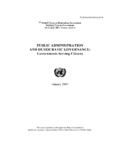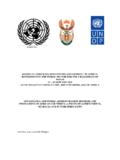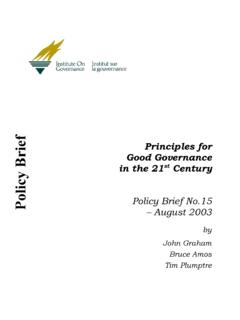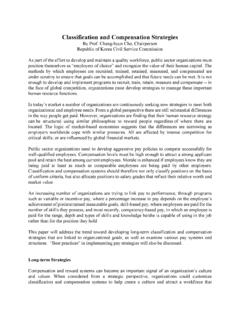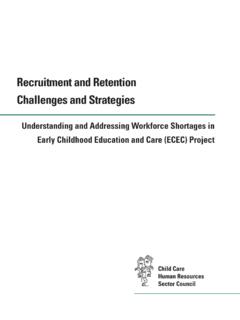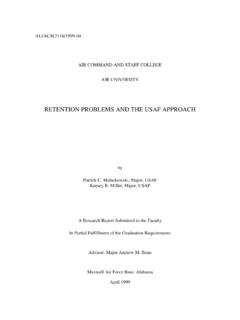Transcription of Recruiting and Staffing in the Public Sector - United Nations
1 Study is sponsored by:This study was conducted by: Recruiting and Staffing in the Public Sector : Results from the IPMA-HR Research SeriesBy: Glenn Davidson, Managing Director Public Sector Stan Lepeak, Managing Director Research and Knowledge ServicesElizabeth Newman, Advisor Public SectorSummer 2007 Page to what and Staffi ng in the Public Sector : Results from the IPMA-HR Research SeriesExecutive SummaryTwo of the most critical activities within the human resources (HR) domain are Recruiting and staffi ng. This involves identifying and attracting the right people to fi ll positions, ranging from upper management and key decision-maker roles to entry-level personnel.
2 Finding the right person for each position and doing so in a cost-effective and timely manner is a challenge for any organization, but it is becoming especially diffi cult for Public Sector entities. This IPMA-HR research study sought to understand what Public Sector HR organizations do to identify and attract qualifi ed applicants, what methods and strategies work well, and what diffi culties organizations encounter in these Sector organizations often are at a disadvantage when compared to the private Sector in Recruiting and staffi ng processes.
3 The private Sector typically outmatches the Public Sector on compensation, including bonuses and various other perks, such as stock options. Previous research indicates that most Public Sector organizations believe competition for talent with the private Sector is increasing and that the ability to offer better compensation packages is a key advantage for private Sector fi rms. Public Sector organizations also often fi nd themselves competing against not only private companies, but each other, in attracting potential employees. Smaller organizations in more isolated regions of the country, for example, fi nd that multiple jurisdictions often compete over the same diminishing applicant pool and, in turn, drive up compensation costs across the region.
4 These factors have forced many Public Sector organizations to develop creative strategies and solutions for Recruiting and staffi ng. Many organizations report positive overall outcomes from temporary workers transitioning to permanent employees. Other organizations are improving their visibility by developing a branding strategy complete with consistent messaging and marketing. Finally, organizations are tapping into professional and cultural networks to reach individuals with specialized skill sets and increase the overall diversity of their workforce.
5 Various new approaches are proving successful, and these models demonstrate great potential for Public Sector HR. At the same time, some of the strategies described here are just the starting point for organizations overhauling Recruiting or staffi ng efforts. HR continues to struggle with gathering data and measuring performance, both important steps in efforts to transform HR operations or utilize alternative models like shared services and outsourcing. Information technology (IT) is an important enabling tool for Recruiting and staffi ng, but overall use of IT remains limited, and even the most advanced systems are not being used to their full potential.
6 EquaTerra conducted the research study, performed the analysis and developed this report on behalf of IPMA-HR and did not receive funding from Adecco. EquaTerra surveyed more than 150 senior-level, Public Sector professionals (see appendix for full survey methodology) to examine the Recruiting and staffi ng processes in the Public Sector and the factors that impact these processes. The respondents represented all major Public Sector categories and were located in the United to what of ContentsExecutive Summary1 Introduction3 Today s Public Sector HR Organization3 The Temporary Workforce4 Measuring Recruiting and Staffi ng Efforts6 Today s Applic ant s6 Information Technology in Recruiting and Staffi ng7 Becoming an Employer of Choice.
7 Branding in the Public Sector9 Outsourcing in Recruiting and Staffi ng11 Today s challenges and Solutions12 Conclusion13 Report Scope and Research Methodology15 Appendix16 About the Organizations Responsible for this Report17 Page to what paraphrase Jim Collins in his book, Good to Great, it is not enough to get the right people on the bus and the wrong people off, but the right people must also be in the right seats. Most Public Sector leaders are familiar with this expression describing the importance of people to the success of an organization.
8 The stakes are often higher in the Public Sector , where organizations are becoming increasingly reliant on less people, given the steady decline in resources and the imposition of constraints that defi ne the Public Sector . The right people with appropriate skill sets and experience enable quality service delivery. Skilled professionals can generate new ideas, improve processes and drive innovation throughout an organization. Unfortunately, the wrong people can do exactly the opposite, and hinder or even damage an organization s performance.
9 Vacant positions can stretch already overburdened employees, resulting in lower productivity and poor morale. Regardless of advanced IT or similar tools available, organizations primarily rely on people; thus, Recruiting and staffi ng are critical organizational published (1Q07) a study titled: The Impact of the Aging Workforce on Public Sector Organizations and Mission. This study addressed the changing environment Public Sector organizations face as more employees become eligible for retirement. Increasing retirement levels combined with a diminishing interest in Public Sector careers by younger workers points to smaller applicant pools and higher competition for qualifi ed applicants in the future.
10 In response to these and other factors, organizations are starting to adapt their approach to Recruiting and staffi ng with varied success. Some of the methods and strategies described here are not entirely new. At the same time, the positive outcomes experienced by some organizations provide important evidence on the need to consider alternatives to traditional strategies and to continue to explore new s Public Sector HR OrganizationTo explore what Public Sector organizations are doing to expand applicant pools and attract qualifi ed applicants, it is important to fi rst consider the current state of Public Sector HR operations.
